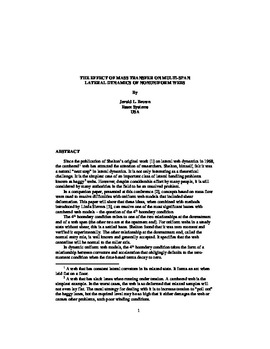| dc.contributor.author | Brown, Jerald L. | |
| dc.contributor.other | International Conference on Web Handling (2017) | |
| dc.date.accessioned | 2019-11-13T20:00:29Z | |
| dc.date.available | 2019-11-13T20:00:29Z | |
| dc.date.issued | 2017-06 | |
| dc.identifier | oksd_icwh_2017_brown2 | |
| dc.identifier.citation | Brown, J. L. (2017, June). The effect of mass transfer on multi-span lateral dynamics of nonuniform webs. Paper presented at the Fourteenth International Conference on Web Handling (IWEB), Stillwater, OK. | |
| dc.identifier.uri | https://hdl.handle.net/11244/322068 | |
| dc.description.abstract | Since the publication of Shelton's original work [1] on lateral web dynamics in 1968, the cambered1 web has attracted the attention of researchers. Shelton, himself, felt it was a natural "next step" in lateral dynamics. It is not only interesting as a theoretical challenge. It is the simplest case of an important class of lateral handling problems known as baggy2 webs. However, despite considerable effort by many people, it is still considered by many authorities in the field to be an unsolved problem. | |
| dc.description.abstract | In a companion paper, presented at this conference [2], concepts based on mass flow were used to resolve difficulties with uniform web models that included shear deformation. This paper will show that these ideas, when combined with methods introduced by Linda Sievers [3], can resolve one of the most significant issues with cambered web models - the question of the 4th boundary condition. | |
| dc.description.abstract | The 4th boundary condition refers to one of the two relationships at the downstream end of a web span (the other two are at the upstream end). For uniform webs in a steady state without shear, this is a settled issue. Shelton found that it was zero moment and verified it experimentally. The other relationship at the downstream end, called the normal entry rule, is well known and generally accepted. It specifies that the web centerline will be normal to the roller axis. | |
| dc.description.abstract | In dynamic uniform web models, the 4th boundary condition takes the form of a relationship between curvature and acceleration that obligingly defaults to the zero-moment condition when the time-based terms decay to zero. | |
| dc.description.abstract | In 2002, Richard Benson published a paper [4] that is similar in some respects to the method discussed here. Although there is no mention of mass flow, he found and applied a key relationship that enforces its effects. He found the relationship by assuming that the rotational velocity of the bending angle of the web must match the pivoting velocity of the roller at the downstream end of a span. Using this, he developed a cambered web model similar to the one described here. However, he incorrectly concluded that camber has no effect on lateral behavior because he overlooked its effects on the boundary conditions. | |
| dc.description.abstract | Benson also derived an acceleration equation for uniform webs that correctly incorporates shear. | |
| dc.format | application/pdf | |
| dc.language | en_US | |
| dc.publisher | Oklahoma State University | |
| dc.rights | In the Oklahoma State University Library's institutional repository this paper is made available through the open access principles and the terms of agreement/consent between the author(s) and the publisher. The permission policy on the use, reproduction or distribution of the article falls under fair use for educational, scholarship, and research purposes. Contact Digital Resources and Discovery Services at lib-dls@okstate.edu or 405-744-9161 for further information. | |
| dc.title | Effect of mass transfer on multi-span lateral dynamics of nonuniform webs | |
| osu.filename | oksd_icwh_2017_brown2.pdf | |
| dc.type.genre | Conference proceedings | |
| dc.type.material | Text | |
